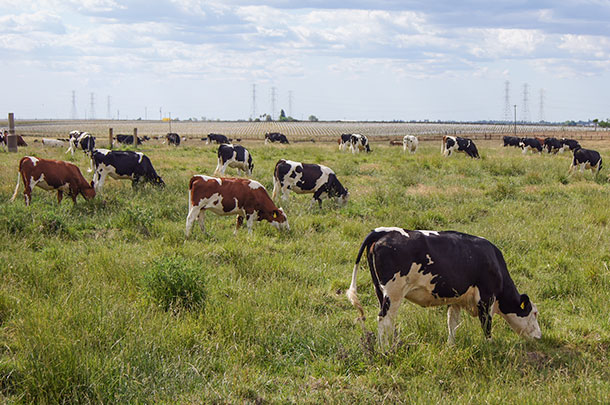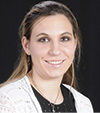If they say two are better than one, how great are three? One California dairy has found success putting three breeds into one cow to reach their goals for a more profitable and efficient herd.
Hoekstra Dairy, run by Bill Hoekstra and sons Jack and Kurt in Oakdale, California, has been crossbreeding for almost 20 years. Just over three years ago, they opened a second facility, Crossview Dairy. Combined, the two herds account for 2,800 milking head and 2,800 replacement heifers on 1,400 acres.
Making the leap
The farm was previously home to a herd of purebred Holsteins, but in 2000 they began crossbreeding with the ProCross method. They wanted a stronger herd that put more emphasis on certain traits other than milk production.
“How could we improve this Holstein when we really weren’t happy with all her functional traits?” says Kurt Hoekstra of their decision. “Milk-wise, she’s a great animal, but we felt our animals were lacking in some areas like strength or health traits, somatic cell and longevity.”
The switch wasn’t an easy one – met with lots of unknowns and some skepticism – but the Hoekstras’ work has since paid off with a herd that’s both efficient and competitive in production.
The Hoekstras weren’t alone in their pursuit; other local dairymen had the same vision to improve their herds. “It’s been a whole journey together,” says Hoekstra. “With Mike Osmundson from Creative Genetics and other local dairyman, it started just by looking at what else is out there.” Their own research led them to try several dairy breeds in their herds, including European breeds such as Normandy, Swedish Red and Montbeliarde. The Hoekstras have found the latter two to be their favorite cross with Holsteins.
“Probably the biggest obstacle was just the unknown,” says Hoekstra. “We had a lot of people that said we were crazy. ... We were okay with that; we had enough faith that we had done our research.” The resulting crossbreds fit so well into the farm’s goals they needed little improvement. Hoekstra says the only thing they refined in their breeding was reducing cow stature. Otherwise, their animals have needed little structural correction.
Building up an effective crossbred herd takes time and a lot of patience to see the intended results. “In the beginning we were all willing to give up some milk,” Hoekstra recalls. The idea was to focus more on a longer productive life than pounds of milk per day. If a crossbred cow could milk even just one lactation longer than the average Holstein, he explains, she would make up the daily loss.
In the mix
The crossing method uses a mix of three breeds in a rotation: Holstein, Swedish Red and Montbeliarde. “We knew the Holsteins had milk. ... We were looking for other functional traits,” Hoekstra says. “That’s what those [other] breeds seem to concentrate on more: health traits, feet and legs, udders and longevity. ... That’s why we decided to stay with the [three-breed] rotation.”
The program works by a generational rotation of sire breeds. For example:
- Generation 1: Montbeliarde sire to Holstein dam
- Generation 2: Swedish Red sire to Generation 1 dam
- Generation 3: Holstein sire to Generation 2 dam
- Generation 4: Montbeliarde sire to Generation 3 dam
And the breeding of each generation continues in that same order of purebred sires.
Since the method uses three breeds that are all unrelated with several different traits and strengths, it offers the maximum heterosis benefit. Hoekstra is unable to pinpoint a sole top advantage he’s noticed with these animals. “There’s no single major benefit,” he says. “What we see are all little incremental ones that add up.”
Over all, the cows are more powerful animals capable of a longer productive life while encountering fewer health problems compared with the previous purebred herd.
Specifically, calf health is better. The dairy experiences fewer stillbirths, and calves on the ground are more vigorous and survivable. The low mortality means more heifers are making it into the milk string, and bull calves have had a marketability advantage. The Hoekstras’ unique genetics have created a demand for their heifers as well. Even cull cows garner increased value, largely due to keeping better body condition throughout their lactations. “Buyers know our animals now, that they yield better,” Hoekstra says.

Efficiency, another hallmark of crossbreeding, goes several ways in the herd. According to Hoekstra, the cows are able to utilize a high-forage diet better than their purebred counterparts. On average, the herd also needs less veterinary attention per animal per year. The enhanced fertility has also been a money saver, with fewer breedings per animal and fewer units of semen being purchased.
And yes, along with everything else, these cows can milk. The herd boasts a respectable 28,000-pound rolling herd average, bolstered by high components and low somatic cell count.
The herd was part of a study conducted by the University of Minnesota. The study looked at seven crossbred dairies in the area and compared them with standard Holsteins in traits such as calving ease, production and reproduction. The intriguing results found that the percentage of first-lactation crossbreds leaving the herd was half that of the Holsteins. Incidence of calving difficulty showed an even greater ratio favoring the crossbreds.
Learning and growing
The Hoekstras’ breeding program priorities have shifted and evolved with their herd of three-way crosses. Milk output, while important, isn’t at the top of trait selection. “We like to have milk, but that’s not one of the most important things we’re looking at,” says Hoekstra. “We want components, good udders, longevity and daughter pregnancy rate. What I think is important is always bringing in the best of each breed.”
He says their success lies in individual sire selection, as much as it does choice of breed. The company from which they purchase their semen selects both top genomic and proven bulls from all over the world. Hoekstra believes the mix of the two is important in their program.
Hoekstra says they are always open-minded, looking to learn from fellow dairymen as much as they’re willing to teach. They regularly provide tours to others interested in seeing crossbred genetics firsthand. He recommends touring as being one of the best things someone exploring crossbred genetics can do. So far, they have hosted interested visitors from 36 different countries. Doing so has opened many doors and relationships with other dairymen across the U.S. and the rest of the world.
“Crossbreeding is different; it’s definitely not the norm,” he says. “Especially when you step out of the regular dairy Holstein box, it can be difficult. We’re never afraid of a phone call or visit from another dairyman.” ![]()
Jaclyn Krymowski is a 2017 Progressive Dairyman editorial intern.
PHOTO 1: A pioneer in crossbreeding, the Hoekstra family has found success with a three-breed cross – Swedish Red, Montbeliarde and Holstein – over the past 20 years. The herd averages 28,000 pounds of milk with high components and low somatic cell count.
PHOTO 2: The three-way cross cows have greater feed efficiency with a higher forage diet than the typical Holstein. The Hoekstras note other benefits such as improved fertility, more viable calves and higher-value cull cows and bull calves. Photos provided by Ami Avila, Creative Genetics.






